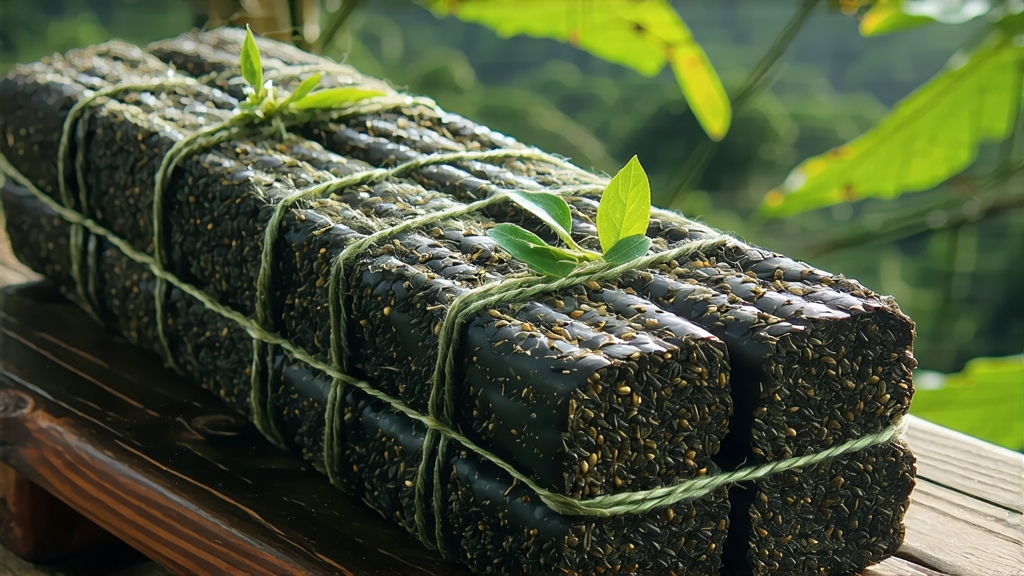
Tucked beneath the humid karst hills of Guangxi, Liupu tea waits like a quiet archive of Chinese history. To the uninitiated it is merely another dark brick on the shelf, yet to the seasoned palate it is a living chronicle of Ming-dynasty horse caravans, Qing-era tax routes, and the invisible craftsmanship of time. International drinkers who know Pu-erh often overlook Liupu, yet this cousin from the south-west shares the same microbial soul while singing in an unmistakably Guangxi accent.
The story begins in 1524, when the Jiajing Emperor decreed that all tea bound for the war-tolerant provinces of the south must be compressed to save weight and deter bandits. Wuzhou prefecture—today’s Liupu county—sat at the confluence of the Xun and Gui Rivers, a natural dock where Yunnan maocha met Lingnan humidity. Jute-sailed boats stacked dark, half-fermented leaves into dark holds; by the time the cargo reached Hong Kong six weeks later the tea had mellowed, its edges rounded by river mist and the body heat of deckhands. Merchants christened the cargo “Liupu” after its river-port birthplace, and a new style of dark tea was born.
Unlike Pu-erh, which relies on Yunnan’s large-leaf Assamica, Liupu is built on the smaller, more sinewy Guangxi native cultivar Camellia sinensis var. sinensis f. Liupuensis. The leaves are naturally higher in catechins but lower in caffeine, a chemistry that encourages the growth of Eurotium cristatum—the same “golden flower” mold celebrated in Hunan’s Fu brick. The result is a liquor that is darker, softer, and mysteriously sweeter than its Yunnan cousin, with a camphor coolness that lingers like evening air above limestone peaks.
Processing starts in early April when the first two leaves and a bud are plucked under a veil of mountain fog. The pickers work barefoot, believing that rubber soles disturb the soil’s qi. After a brief outdoor withering on split-bamboo trays, the leaves are wok-fired at 190 °C for exactly four minutes—long enough to kill green enzymes yet short enough to preserve leaf integrity. Rolling follows, but Guangxi craftsmen use a peculiar “pine-bark knead,” pressing the leaf against rough wooden planks that impart microscopic scratches; these nicks become entry points for later microbial colonization.
The hallmark step is “wet piling,” yet Liupu’s version is gentler than the heavy dui-er of Pu-erh. Leaves are sprayed with mineral-rich spring water, then stacked 45 cm high inside bamboo crates lined with banana leaves. Every 48 hours a barefoot worker “walks” the pile, inserting a forearm to feel temperature and sniff for over-fermentation. After 18–22 days the leaves turn chestnut-brown, releasing a scent reminiscent of damp forest floor and dried longan. A final low-temperature bake fixes the aroma before the tea is left to nap for three months in a camphor-wood loft, absorbing the tree’s insect-repelling perfume.
Compression arrives in autumn. Traditional Liupu is shaped into 1 kg “book bricks” using hand-carved teak molds etched with the characters for “River Harmony.” A square of mulberry paper is laid on each brick, then forty bricks are bound into a bamboo cage called a lang. These cages are rolled into riverside caves where relative humidity hovers at 85 % and temperature stays a steady 22 °C. Inside the cave the tea continues a slow, micro-aerobic fermentation for anywhere from three to fifty years. The bamboo slats breathe, the camphor lingers, and Eurotium spores bloom into tiny golden stars visible under a loupe.
Modern Liupu is categorized into four grades: Cave Aged (dong cang), Bamboo Aged (zhu cang), Warehouse Aged (cang zhu), and Press & Drink (ya zhi). Cave Aged bricks, rarely seen outside Guangxi, carry a petrichor minerality and a jujube sweetness that can last twenty infusions. Bamboo Aged versions are lighter, with hints of orchid and star anise, while Warehouse Aged teas develop woody bass notes and a silky texture. Press & Drink Liupu is produced for immediate consumption; it undergoes only 45 days of wet piling